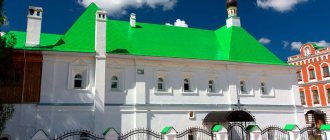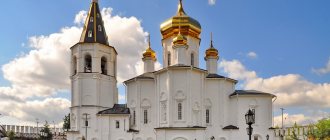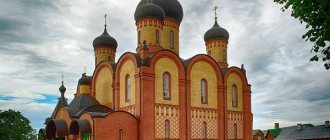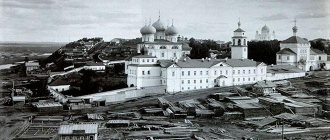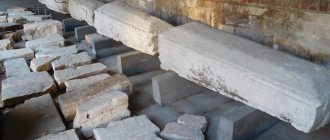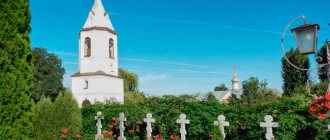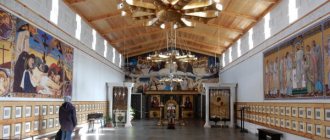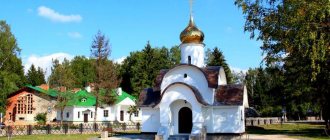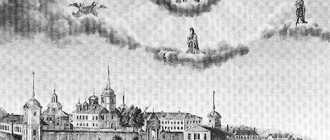Mir
Russia Bryansk region Suponevo village Assumption Svensky Monastery Map loading in progress...
{"format":"leaflet","minzoom":false,"maxzoom":false,"limit":50,"offset":0,"link":"all","sort":[""], "order":[],"headers":"show","mainlabel":"","intro":"","outro":"","searchlabel":"\u2026 \u0441\u043b\u0435\ u0434\u0443\u044e\u0449\u0438\u0435 \u0440\u0435\u0437\u0443\u043b\u044c\u0442\u0430\u0442\u044b","default":"","import-annotation":false,"width ":"auto","height":"350px","centre":{"text":"","title":"""link":"""lat":53.20600900000000166301106219179928302764892578125,"lon": 34.3291430000000019617800717242062091827392578125,"icon":""},"title":"","label":"","icon":"","lines":[],"polygons":[],"circles":[ ],"rectangles":[],"copycoords":false,"static":false,"zoom":8,"defzoom":14,"layers":["OpenStreetMap"],"image layers":[] ,"overlays":[],"resizable":false,"fullscreen":true,"scrollwheelzoom":true,"cluster":false,"clustermaxzoom":9,"clusterzoomonclick":true,"clustermaxradius":80, "clusterspiderfy":true,"geojson":"","clicktarget":"","showtitle":true,"hidenamespace":false,"template":"","userparam":"","activeicon": "","pagelabel":false,"ajaxcoordproperty":"","ajaxquery":"","locations":[{"text":"\u003Cb\u003E\u003Ca href=\"/palomnik/%D0% A3%D1%81%D0%BF%D0%B5%D0%BD%D1%81%D0%BA%D0%B8%D0%B9_%D0%A1%D0%B2%D0%B5%D0%BD% D1%81%D0%BA%D0%B8%D0%B9_%D0%BC%D1%83%D0%B6%D1%81%D0%BA%D0%BE%D0%B9_%D0%BC%D0% BE%D0%BD%D0%B0%D1%81%D1%82%D1%8B%D1%80%D1%8C\" title=\"\u0423\u0441\u043f\u0435\u043d\u0441\u043a\ u0438\u0439 \u0421\u0432\u0435\u043d\u0441\u043a\u0438\u0439 \u043c\u0443\u0436\u0441\u043a\u043e\u0439 \u043c\u043e\u043d\u 0430\u0441\u0442\u044b\u0440\ u044c\"\u003E\u0423\u0441\u043f\u0435\u043d\u0441\u043a\u0438\u0439 \u0421\u0432\u0435\u043d\u0441\u043a\u0438\u0439 \u043c\ u0443\u0436\u0441\u043a\ u043e\u0439 \u043c\u043e\u043d\u0430\u0441\u0442\u044b\u0440\u044c\u003C/a\u003E\u003C/b\u003E\u003Chr /\u003E\u003Ca href=\"/palomnik/ %D0% A1%D0%B2%D0%BE%D0%B9%D1%81%D1%82%D0%B2%D0%BE:%D0%90%D0%BD%D0%BD%D0%BE%D1%82 %D0%B0%D1%86%D0%B8%D1%8F\" title=\"\u0421\u0432\u043e\u0439\u0441\u0442\u0432\u043e:\u0410\u043d\u043d\u043e\u0442\ u0430\u0446\u0438\u044f\»\u003E\u0410\u043d\u043d\u043e\u0442\u0430\u0446\u0438\u044f\u003C/a\u003E: \u043f\u0440\u0430\u043 2\u043e\u0441\u043b \u0430\u0432\u043d\u044b\u0439 \u043c\u0443\u0436\u0441\u043a\u043e\u0439 \u043c\u043e\u043d\u0430\u0441\u0442\u044b\u0440\ u044c\u0432\u0411\u0440\u044f \u043d\u0441\u043a\u043e\u0439 \u043e\u0431\u043b\u0430\u0441\u0442\u0438. 1288 1288 \u0441\u043a\u0438\u043c \u043a\ u043d\u044f\u0437\u0435\u043c \u0420\u043e\u043c\u0430\u043d\u043e\u043c \u041c\u0438\u0445\u0430\u0439\u043b\u043e\u0432\u0 438\u0447\u0435\u043c. \u0412 1920-\u0435 \u0433\u043e\u0434\u044b \u043d\u0430\u0447\u0430\u043b\u043e\u0441\u044c \u043f\u043e\u0441\u0442\u0435 \u043f\u0435\u043d\u043d\u043e \u0435 \u0437\u0430\u043a\u0440\u044b\u0442\u0438\u0435 \u043c\u043e\u043d\u0430\u0441\u0442\u044b\u0440\u044f, \u043a\u043 e\u0442\u043e\u0440\u043e\ u0435 \u0431\u044b\u043b\u043e \u043f\u043e\u043b\u043d\u043e\u0441\u0442\u044c\u044e \u0437\u0430\u0432\u0435\u0440\u0448\u 0435\u043d\u043e\u043a 1926\u0433 \u043e\u0434\u0443. \u041c\u043e\u043d\u0430\u0441\u0442\u044b\u0440\u044c \u0432\u043e\u0437\u0432\u0440\u0430\u0449\u0435\u043d \u0426\u0435\ u0440\u043a\u0432\u0438\u0432 1992 \u0433\u043e\u0434\u0443.","title":"\u0423\u0441\u043f\u0435\u043d\u0441\u043a\u0438\u0439 \u0421\u0432\u0435\u043d\u0441\u 043a\u0438\ u0439 \u043c\u0443\u0436\u0441\u043a\u043e\u0439 \u043c\u043e\u043d\u0430\u0441\u0442\u044b\u0440\u044c","link":"","lat":53.2060090 0000000166301106219179928302764892578125,”lon ":34.3291430000000019617800717242062091827392578125,"icon":""}],"imageLayers":[]}
53.208079; 34.319677
Russia, Bryansk district, Suponevskoye rural settlement, Suponevo village
Suponevo village, Bryansk region
Russia
Telephone:
(4832) 92-20-74
Email:
Assumption Svensky Monastery
- Orthodox male monastery in the Bryansk region. It was founded in 1288 by the Bryansk prince Roman Mikhailovich. In the 1920s, the gradual closure of the monastery began, which was completely completed by 1926. The monastery was returned to the Church in 1992.
History[edit]
The monastery was founded, according to legend, in 1288 by the Bryansk prince Roman Mikhailovich. Legend has it that the prince suddenly began to lose his sight. For healing, he sent to the Kiev Pechersk Monastery for a miraculous icon - the Pechersk Icon of the Mother of God. While traveling along the Desna, the icon miraculously disappeared from the boat and ended up on the banks of the Sven River, where the prince came. After praying in front of the icon, he was healed. At this place, he ordered to found a monastery, cut down a temple in the name of the Mother of God, and endowed it with lands. Based on the name of the Svini River, the monastery was called Svinsky until the 17th century.
Documentary information about the existence of the monastery appears in the 16th century, when Ivan the Terrible ordered two stone churches to be built here, including the Church of Sts., restored in 2011. Anthony and Theodosius of Pechersk. In 1583 the monastery was destroyed by the Lithuanians, and in 1664 by the Crimean Tatars.
The architectural ensemble of the monastery belongs to the Sloboda Baroque tradition. In 1679, the gateway Church of Sretenskaya was erected, which has survived to this day. According to church legend, Peter I visited the monastery. The house where he allegedly spent the night was preserved until the beginning of the 20th century, and the “oak of Peter the Great” still stands in front of the monastery, being a famous landmark.
In 1681-1786, the monastery was assigned to the Kiev-Pechersk Lavra and bore the name Novo-Pechersk. During these years, the gateway Church of the Transfiguration of the Savior (1742) and the monumental Assumption Cathedral (1758, demolished in 1930) were built here. A fair, one of the largest in western Russia, was noisy in front of the walls of the monastery.
After the monastery returned to its independent status, in order to avoid the previous dissonant name, it was named Svensky, and accordingly the river Svin was renamed Sven. According to the Manifesto on the secularization of monastic lands (1764), the monastery was classified as third class.
The Svenskaya (Pechersk) Icon of the Mother of God (with Anthony and Theodosius of Pechersk) after the October Revolution was taken to Moscow, to the Tretyakov Gallery. According to tradition, it is attributed to the Kiev-Pechersk icon painter Alypiy (11th century).
In the 1920s, a gradual closure of the monastery began, which was completely completed by 1926, and in 1930, a significant part of the monastery buildings, including the main cathedral, was demolished. The Assumption Cathedral was blown up by a group of demolitionists under the leadership of Rykhlov. The Church of St. Anthony and Theodosius of the Pechersk was also damaged by the explosion; only the lower tier remained from it.
The surviving buildings were returned to the church in 1992, when the monastery itself was restored. As of 2014, restoration of the architectural complex, including the blown-up cathedral, is underway.
Abbots, governors
- Sergius (mentioned ca. 1567) abbot.
- …
- Isaiah
- Jonah II
- Paul
- Sylvester
- James I
- Varlaam II
- Mark I
- Barsanuphius
- Job II
- Jonah III
- James II
- Theodosius I
- James III
- Hermogenes (mentioned 1655 - mentioned 1657)
- James IV
- Mark II (mentioned 1659)
- Barnabas (Glybotsky) (mentioned 1664)
- Nicodemus (? - 1672) abbot.
- Filaret (Levshin) (1673 - September 2, 1679)
- Markell, Archimandrite
- Nikon I, archim.
- St. John (Maksimovich) (ca. 1681 - 1684)
- Strength (Zharovsky) (1685 - 1699)
- Afanasy (Mislavsky) (mentioned 1701)
- St. Philofey (Leshchinsky) (1701 - 1702)
- Serapion (1702 - 1704) Hierom.
- Anthony (Tarasevich) (1705 - 1710)
- Modest (Ilnitsky) (mentioned 1710)
- Barsanuphius (Rostotsky) (mentioned June 10, 1734)
- Joel (Savitsky) (mentioned 1738)
- Gennady (Vasinsky) (mentioned 1744 - mentioned 1745)
- Luka (Belousovich) (1745 – mentioned 1749)
- Gervasius (c. 1750 - September 13, 1752)
- Hierotheus (1752 - 1755)
- Ignatius (Voitsekhovich) (+March 23, 1761)
- Irakli (Lyatoshevich) (1761 - January 10, 1766)
- Callistus (January 10, 1766 - mentioned 1768)
- Palladium (April 3, 1770 - July 7, 1787)
- Modest (October 14, 1787 - October 22, 1796), elevated to archimandrite and appointed abbot to the Oryol Assumption Monastery
- Nikon (October 22, 1796 - October 16, 1797), elevated to archimandrite and moved as abbot to the Tolga Monastery
- Eleazar (March 20, 1798 - September 10, 1798), moved by abbot to the Bryansk Peter and Paul Monastery
- Theodosius (September 10, 1798 - October 19, 1799), one of the abbots of the Bryansk Peter and Paul Monastery
- Manuil (Korchak-Kotovich) (March 4, 1800 - 1801), elevated to archimandrite and appointed abbot to the Oryol Assumption Monastery
- Israel (Zvegintsev) (March 25, 1801 - 1801), left for St. Petersburg as governor of the Alexander Nevsky Lavra
- St. Filaret (Amphitheaters) (March 11, 1802 [2] - October 10, 1804)
- Dionysius (Tsvetaev) (December 25, 1804 - October 22, 1805)
- Ambrose I (20 May 1806 - 1808)
- Ambrose II (October 31, 1809 – July 9, 1833)
- Sergius (August 6 - August 22, 1833)
- Dometius (November 12, 1833 - January 2, 1835)
- Venedikt (Kurkovsky) (June 24, 1837 - April 1839)
- Christopher (Emmaus) (June 24 - July 1837)
From 1924 to 1992 the monastery was abolished
- Nikodim (Aniskin) (October 16, 1992 - October 27, 2010)
- Mitrofan (Okhalov) (May 30, 2011 - June 7, 2012)
- Alexy (Tyurin) (May 29, 2013 - December 9, 2020)
- Tikhon (Kolesnyak) (from December 10, 2022 [11]), acting
Patronal holidays[edit]
Dormition of the Blessed Virgin Mary
- August 28
Transfiguration
- August 19
Presentation of the Lord
- February, 15
Anthony and Theodosius of Pechersk, reverends
— July 23, May 16, etc.
Illness of the Pious Prince
A legend is associated with its foundation, which, as the inhabitants of the monastery assure, did not arise out of nowhere. It tells that the pious prince of Chernigov and Debryansky Roman Mikhailovich, who ruled these regions at the end of the 13th century, once suffered a serious illness - he began to go blind, so much so that every day the white light in his eyes faded away. At that time there were no doctors at the prince’s court, and God forbid to turn to sorcerers and healers! - a baptized person. What can he hope for? Only by the grace of God.
So the prince sent the archimandrite of the local monastery to Kyiv to bring him the miraculous icon of the Mother of God, through prayers before which healing had been granted to the suffering more than once. The prince’s word is the law, and the man of God set out on the road, taking with him five monks who were humble in heart, but very strong in flesh - times were turbulent, and anything could happen on the road.
How to get there[edit]
Address
: Russia, Bryansk region, Bryansk district, Suponevo village, st. Frunze, 1 B
The Svensky Monastery is located in the village of Suponevo, a suburb of Bryansk. You can get to Bryansk from Moscow by train (from Kievsky station) or bus (from Teply Stan metro station). From the Bryansk railway station you need to take trolleybus No. 1 to the “Telecenter” stop, then go (through a small market) to bus stop No. 7, which will take you to the Svensky Monastery. The same bus No. 7 runs from the bus station. In addition, you can get to the monastery by minibuses No. 36 and 45. By car to Bryansk you should leave Moscow along the Kyiv Highway. Distance - 380 kilometers.
Schedule of services
Services are held in the monastery every day, evening services begin at 17.00, liturgy on weekdays at 8.00. On Sundays there are two liturgies: an early one at 8.00 and a late one at 10.00.
Divine service in the Svensky Monastery
On all days after the liturgy, a prayer service to the saint of the day and a memorial service for the departed are required.
On ordinary weekdays, Vespers and Matins are served in the evening, and on Sundays and holidays there is an all-night vigil. On the monastery website there is a schedule for each day, indicating the holidays and memory of the saints of each day.
Ruins returned to people
But the wheel of history does not stand still. Having swept across the country with all the hardships that befell it in the 20th century, in the end it plunged Russia into the stormy ocean of perestroika. In 1992, the Svensky Monastery (Bryansk) was returned to the jurisdiction of the Church. By this time, of all the previous buildings, only the Sretenskaya and Transfiguration churches, which required major repairs, had survived, as well as the remains of the monastery walls and several former economic buildings that were in disrepair.
Other buildings were destroyed, and not even a trace remained of most of them, and in the surviving ruins it was difficult to recognize the former Svensky Monastery (Bryansk), known from archival documents. The photos published in the article give an idea of the scale of the work carried out.
Miracle Revealed on the River Bank
The princely envoys were already sailing back along the Desna River and carrying the treasured icon with them, when suddenly a certain misfortune befell them - the boat, which had so vigorously cut through the river streams, suddenly froze in place, stopped by an unknown force. No matter how hard the rowers tried, no matter how hard they leaned on the oars, they could not move either up or downstream. There was nothing to do, we somehow made it to the shore and spent the night.
In the morning they missed it - there was no icon, it was gone! They rushed to search, trying not to think about what reward awaited them for such service. But God is merciful - the loss was found. They found her among the branches of a mighty oak tree that stood at the bend of the river. Although the monks were timid, they did not dare to touch the image, but hastened to inform the prince about the miracle that had happened. He did not hesitate to appear and, falling to his knees, prayed for a long time. Then everything happened according to the laws of the genre - the prince saw the light and ordered to found a monastery on this place, which has survived to this day and is known as the Svensky Monastery.
By the way, an interesting detail - in ancient times the river Sven, which gave its name to the monastery, was called Svin, and the monastery, accordingly, was called Svinskaya, which was very dissonant and gave rise to inappropriate witticisms. To correct the situation, in the 17th century it was decided to change only one letter in its name, but at the same time it was necessary to rename the entire river. Since then, the Sven River appeared on maps, and with it the Svensky Monastery.
The coming of hard times
From the beginning of the twenties, the Bolsheviks who came to power began to gradually but systematically close the monastery. When a campaign to confiscate church property swept across the country, allegedly aimed at fighting hunger, everything that was of interest to the new government was removed from the monastery.
Church utensils collected there over many centuries were taken out of churches, bells were removed and sent for melting down, and gold and silver frames were mercilessly stripped from icons. It seemed that the times of the Lithuanian and Tatar invaders had returned. Systematic looting continued until 1926, after which the Svensky Monastery was closed.
